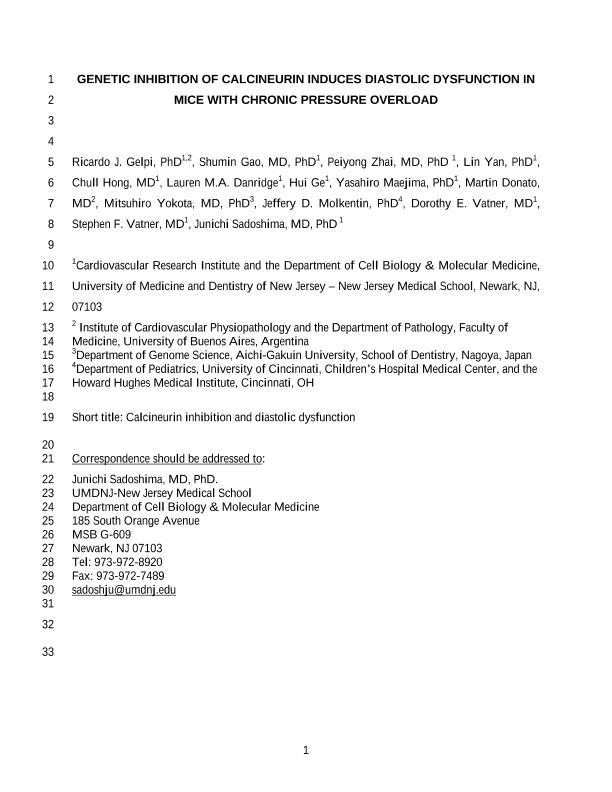Artículo
Genetic inhibition of calcineurin induces diastolic dysfunction in mice with chronic pressure overload
Gelpi, Ricardo Jorge ; Gao, Shumin; Zhai, Peiyong; Yan, Lin; Hong, Chull; Danridge, Lauren M. A.; Ge, Hui; Maejima, Yasahiro; Donato, Martin Alejandro; Yokota, Mitsuhiro; Molkentin, Jeffery D.; Vatner, Dorothy E.; Vatner, Stephen F.; Sadoshima, Junichi
; Gao, Shumin; Zhai, Peiyong; Yan, Lin; Hong, Chull; Danridge, Lauren M. A.; Ge, Hui; Maejima, Yasahiro; Donato, Martin Alejandro; Yokota, Mitsuhiro; Molkentin, Jeffery D.; Vatner, Dorothy E.; Vatner, Stephen F.; Sadoshima, Junichi
 ; Gao, Shumin; Zhai, Peiyong; Yan, Lin; Hong, Chull; Danridge, Lauren M. A.; Ge, Hui; Maejima, Yasahiro; Donato, Martin Alejandro; Yokota, Mitsuhiro; Molkentin, Jeffery D.; Vatner, Dorothy E.; Vatner, Stephen F.; Sadoshima, Junichi
; Gao, Shumin; Zhai, Peiyong; Yan, Lin; Hong, Chull; Danridge, Lauren M. A.; Ge, Hui; Maejima, Yasahiro; Donato, Martin Alejandro; Yokota, Mitsuhiro; Molkentin, Jeffery D.; Vatner, Dorothy E.; Vatner, Stephen F.; Sadoshima, Junichi
Fecha de publicación:
11/2009
Editorial:
American Physiological Society
Revista:
American Journal of Physiology - Heart and Circulatory Physiology
ISSN:
0363-6135
Idioma:
Inglés
Tipo de recurso:
Artículo publicado
Clasificación temática:
Resumen
Genetic inhibition of calcineurin induces diastolic dysfunction in mice with chronic pressure overload. Am J Physiol Heart Circ Physiol 297: H1814 –H1819, 2009. First published August 28, 2009; doi:10.1152/ajpheart.00449.2009.—Calcineurin is a Ca2 /calmodulin-dependent protein phosphatase that induces myocardial growth in response to several physiological and pathological stimuli. Calcineurin inhibition, induced either via cyclosporine or genetically, can decrease myocardial hypertrophy secondary to pressure overload without affecting left ventricular (LV) systolic function. Since hypertrophy can also affect LV diastolic function, the goal of this study was to examine the effects of chronic pressure overload (2 wk aortic banding) in transgenic (Tg) mice overexpressing Zaki-4 (TgZ), a specific endogenous inhibitor of calcineurin, on LV diastolic function. As expected, in the TgZ mice with calcineurin inhibitor overexpression, aortic banding reduced the degree of LV hypertrophy, as assessed by LV weight-to-body weight ratio (3.5 0.1) compared with that in non-Tg mice (4.6 0.2). LV systolic function remained compensated in both groups with pressure overload. However, the LV end-diastolic stress-to-LV end-diastolic dimension ratio, an index of diastolic stiffness and LV pressure half-time and isovolumic relaxation time, two indexes of isovolumic relaxation, increased significantly more in TgZ mice with aortic banding. Protein levels of phosphorylated phospholamban (PS16), sarco(endo)plasmic reticulum Ca2 -ATPase 2a, phosphorylated ryanodine receptor, and the Na /Ca2 exchanger were also reduced significantly (P 0.05) in the banded TgZ mice. As expected, genetic calcineurin inhibition inhibited the development of LV hypertrophy with chronic pressure overload but also induced LV diastolic dysfunction, as reflected by both impaired isovolumic relaxation and increased myocardial stiffness. Thus genetic calcineurin inhibition reveals a new mechanism regulating LV diastolic function.
Palabras clave:
hypertrophy
,
Diastole
,
Hemodynamics
Archivos asociados
Licencia
Identificadores
Colecciones
Articulos(IBIMOL)
Articulos de INSTITUTO DE BIOQUIMICA Y MEDICINA MOLECULAR
Articulos de INSTITUTO DE BIOQUIMICA Y MEDICINA MOLECULAR
Citación
Gelpi, Ricardo Jorge; Gao, Shumin; Zhai, Peiyong; Yan, Lin; Hong, Chull; et al.; Genetic inhibition of calcineurin induces diastolic dysfunction in mice with chronic pressure overload; American Physiological Society; American Journal of Physiology - Heart and Circulatory Physiology; 297; 5; 11-2009; 1814-1819
Compartir
Altmétricas



